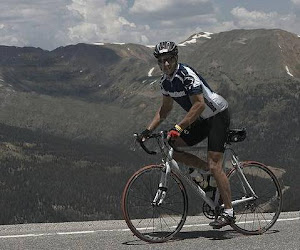Here's a good article by Chris Carmichael. Plyometrics is a form of resistance training used to elicit power through explosive movements. I'm all for it. Here's a good workout:
Build Power, Save Time with this Double-Header Workout
By Chris Carmichael
Everyone knows the wintertime training lays the foundation for a successful summer season, but there’s still plenty of debate about the specifics – particularly when it comes to the idea of gaining power on the bike by heading into the gym to lift weights. I first heard the idea more than 30 years ago as a junior, and experts are still trying to decide if resistance training in the winter really improves cycling performance. You want to know the answer? For the vast majority of cyclists, resistance training won’t make you faster.
To make significant gains in on-bike strength and power, you need to be in the gym a minimum of three hours a week. That doesn’t sound so bad until you realize that, based on my observation of several thousand CTS-coached athletes, the average cyclist with a full-time job and a life can only squeeze out about 8-10 hours of total training time each week, if they really work at it. So why use 30 to 40 percent of that time doing something that may or may not make you faster when you know that more time on the bike will absolutely make you faster? Besides, there’s a way cyclists can effectively build explosive on-bike power without really cutting into your riding time: plyometrics.
Plyometrics are exercises that use explosive movements to bridge the gap between strength and power – and improve both. Most are jumping exercises targeted at making your muscles exert maximum force faster. Why is this more important for cyclists than pure strength? With strength you can push a big gear; with power you can push the same gear faster, which means you go faster. I also like plyometrics for cyclists because the exercises target large muscle groups, help them work together with greater synchronicity, and enhance balance and coordination – things you don’t get from traditional, muscle-isolating weight lifting.
The Double Header Workout
What I’ve found to be most effective in boosting power fast is combining a plyometrics session with high-intensity on-bike intervals in the same day. The jumps recruit fast-twitch muscle fibers in your legs, hips, and buttocks, which means they’re primed for action when you get on your bike. Try the following workout twice a week through the end of March. Do the plyos right before you get on your bike or within a few hours before your ride. Before you throw yourself right into jumping exercises, warm up with a simple 5-10 minutes of brisk walking and 2-3 trips up and down a flight of stairs.
Squat and Jump: About 5 minutesStand with your feet slightly wider than shoulder width apart (in sneakers or bare feet, not cycling shoes!). With your arms at your sides, squat until your hips reach knee level, keeping your weight back and your knees even with or behind your toes. Then explode straight up and jump as high as you can, swinging your arms upward to generate momentum and more height. As you land, bend your knees to absorb impact. Immediately return to a standing position and repeat. Beginners should do two sets of 10 jumps, intermediates three sets of 10, and advanced riders two sets of 15-20 jumps. Rest 1 minute between sets.
Training ride with CTS PowerIntervals: total time 60 minutesPowerIntervals are short, hard efforts designed to boost your top-end power, but also to improve performance at any speed, so they’re worth doing even if you don’t intend to sprint for a single finish line this year. Warm up for 15 minutes. 4 x 1 minute at max effort (as fast as you can sustain), with 1 minute easy spinning recovery between each. These are very hard, and the time between intervals is purposely too short to provide full recovery. Beginners should do one set, intermediate riders two sets, and advanced riders three sets. Take 8 minutes of easy spinning between sets. When you’re done with the intervals, enjoy the rest of your ride.
Tuesday, November 18, 2008
Subscribe to:
Post Comments (Atom)





No comments:
Post a Comment